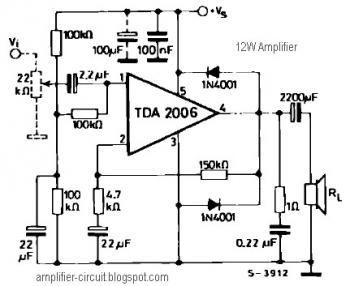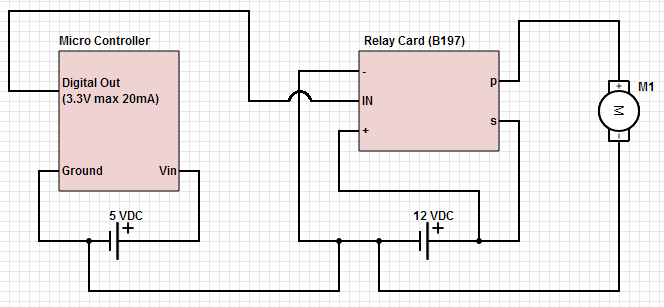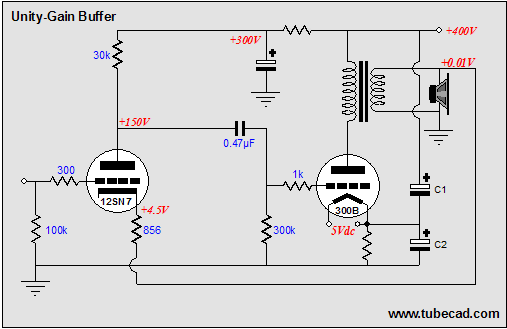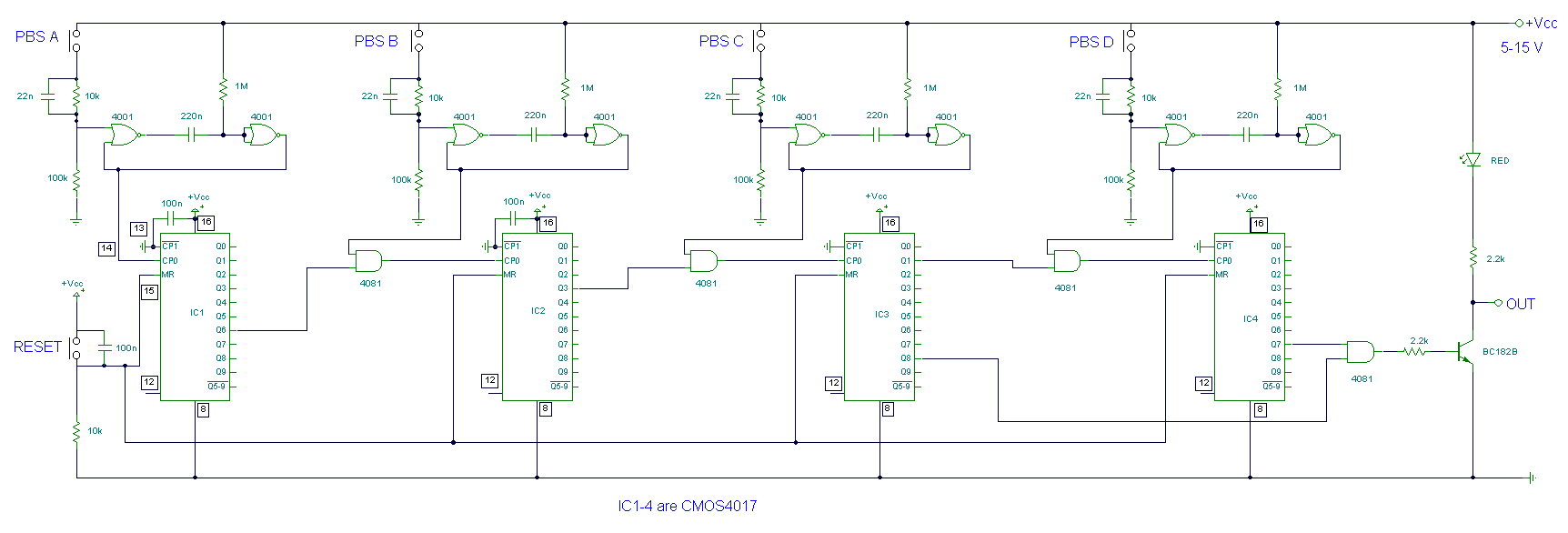
12W Audio Amplifier Circuit with TDA2006

The power amplifier IC TDA2006 provides high output current and has very low harmonic and cross-over distortion. Furthermore, the device incorporates an original (and patented) short circuit protection system that automatically limits the dissipated power to keep the working point of the output transistors within their safe operating area. A conventional thermal shutdown system is also included. An audio amplifier is an electronic amplifier that amplifies low-power audio signals (signals composed primarily of frequencies between 20 - 20,000 Hz, the human range of hearing) to a level suitable for driving loudspeakers and serves as the final stage in a typical audio playback chain. The preceding stages in such a chain are low-power audio amplifiers that perform tasks such as pre-amplification, equalization, tone control, mixing/effects, or audio sources like record players, CD players, and cassette players. Most audio amplifiers require these low-level inputs to adhere to line levels. While the input signal to an audio amplifier may measure only a few hundred microwatts, its output may be tens, hundreds, or thousands of watts. More information about power audio amplifiers can be found on Wikipedia. This is a video tutorial about how to build a really simple headphone amplifier. The circuit is powered by a 9V battery and uses an IC to amplify the input signal from an MP3 player.
The TDA2006 power amplifier IC is designed for high-efficiency audio amplification, making it suitable for various applications in consumer electronics. It operates within a wide frequency range, ensuring compatibility with standard audio signals. The low harmonic and cross-over distortion characteristics of the TDA2006 enhance sound quality, making it ideal for high-fidelity audio systems.
The patented short circuit protection system is a notable feature of the TDA2006, enabling it to automatically limit power dissipation. This function is crucial in preventing damage to the output transistors under fault conditions, thereby extending the lifespan of the amplifier. Additionally, the thermal shutdown system provides an extra layer of safety by cutting off the amplifier's operation when excessive heat is detected, protecting both the IC and connected components.
In a typical audio playback chain, the TDA2006 would be positioned as the final amplification stage. It receives low-level audio signals from preceding stages, such as pre-amplifiers and equalizers. These signals, which may be weak and require amplification, are transformed by the TDA2006 into a robust output capable of driving loudspeakers effectively.
The design considerations for implementing the TDA2006 include ensuring adequate power supply decoupling and thermal management to optimize performance. When designing a simple headphone amplifier circuit using this IC, a 9V battery can be utilized as a power source, and the circuit can be configured to amplify audio signals from devices such as MP3 players. The incorporation of appropriate resistor and capacitor values will also be essential to achieve desired gain levels and frequency response.
Overall, the TDA2006 is an exemplary choice for audio amplification applications, offering a combination of performance, safety features, and ease of integration into various electronic designs.The power amplifier IC TDA2006 provides high output current and has very low harmonic and cross-over distortion. Further the device incorporates anoriginal (and patented)short circuit protection system comprising an arrangement for automatically limiting the dissipated power so as to keep the working point of the output transistors within their sa
fe operating area. A conventional thermal shutdown system is also included. An audio amplifier is an electronic amplifier that amplifies low-power audio signals (signals composed primarily of frequencies between 20 - 20 000 Hz, the human range of hearing) to a level suitable for driving loudspeakers and is the final stage in a typical audio playback chain. The preceding stages in such a chain are low power audio amplifiers which perform tasks like pre-amplification, equalization, tone control, mixing/effects, or audio sources like record players, CD players, and cassette players.
Most audio amplifiers require these low-level inputs to adhere to line levels. While the input signal to an audio amplifier may measure only a few hundred microwatts, its output may be tens, hundreds, or thousands of watts. More explanation about power audio amplifier can be found at wikipedia. org This is the video tutorial about how to build a realy simple headphone amplifier. The circuit powered with 9V battery and use an IC to amplify the input signal from mp3 player. 🔗 External reference
The TDA2006 power amplifier IC is designed for high-efficiency audio amplification, making it suitable for various applications in consumer electronics. It operates within a wide frequency range, ensuring compatibility with standard audio signals. The low harmonic and cross-over distortion characteristics of the TDA2006 enhance sound quality, making it ideal for high-fidelity audio systems.
The patented short circuit protection system is a notable feature of the TDA2006, enabling it to automatically limit power dissipation. This function is crucial in preventing damage to the output transistors under fault conditions, thereby extending the lifespan of the amplifier. Additionally, the thermal shutdown system provides an extra layer of safety by cutting off the amplifier's operation when excessive heat is detected, protecting both the IC and connected components.
In a typical audio playback chain, the TDA2006 would be positioned as the final amplification stage. It receives low-level audio signals from preceding stages, such as pre-amplifiers and equalizers. These signals, which may be weak and require amplification, are transformed by the TDA2006 into a robust output capable of driving loudspeakers effectively.
The design considerations for implementing the TDA2006 include ensuring adequate power supply decoupling and thermal management to optimize performance. When designing a simple headphone amplifier circuit using this IC, a 9V battery can be utilized as a power source, and the circuit can be configured to amplify audio signals from devices such as MP3 players. The incorporation of appropriate resistor and capacitor values will also be essential to achieve desired gain levels and frequency response.
Overall, the TDA2006 is an exemplary choice for audio amplification applications, offering a combination of performance, safety features, and ease of integration into various electronic designs.The power amplifier IC TDA2006 provides high output current and has very low harmonic and cross-over distortion. Further the device incorporates anoriginal (and patented)short circuit protection system comprising an arrangement for automatically limiting the dissipated power so as to keep the working point of the output transistors within their sa
fe operating area. A conventional thermal shutdown system is also included. An audio amplifier is an electronic amplifier that amplifies low-power audio signals (signals composed primarily of frequencies between 20 - 20 000 Hz, the human range of hearing) to a level suitable for driving loudspeakers and is the final stage in a typical audio playback chain. The preceding stages in such a chain are low power audio amplifiers which perform tasks like pre-amplification, equalization, tone control, mixing/effects, or audio sources like record players, CD players, and cassette players.
Most audio amplifiers require these low-level inputs to adhere to line levels. While the input signal to an audio amplifier may measure only a few hundred microwatts, its output may be tens, hundreds, or thousands of watts. More explanation about power audio amplifier can be found at wikipedia. org This is the video tutorial about how to build a realy simple headphone amplifier. The circuit powered with 9V battery and use an IC to amplify the input signal from mp3 player. 🔗 External reference





